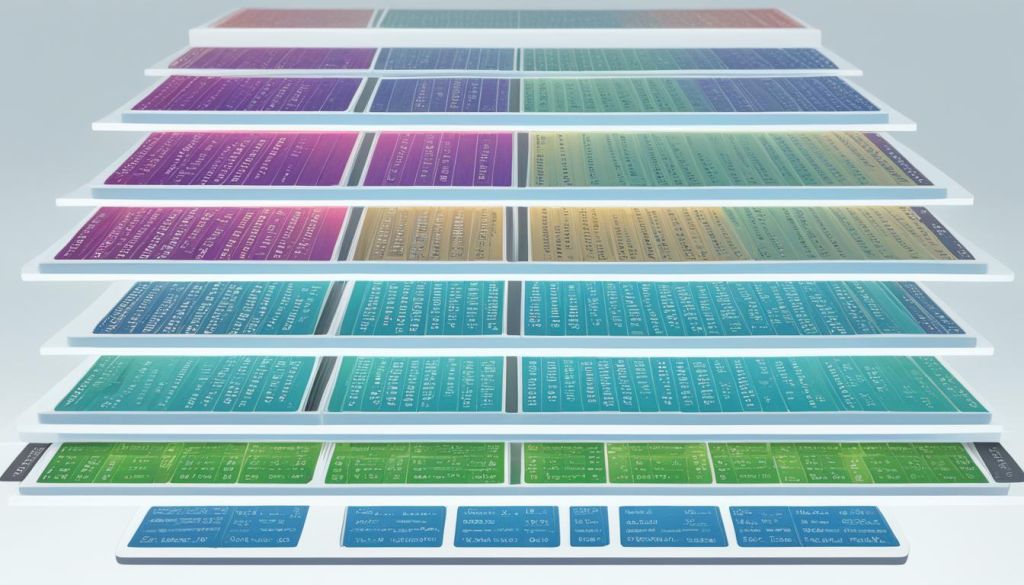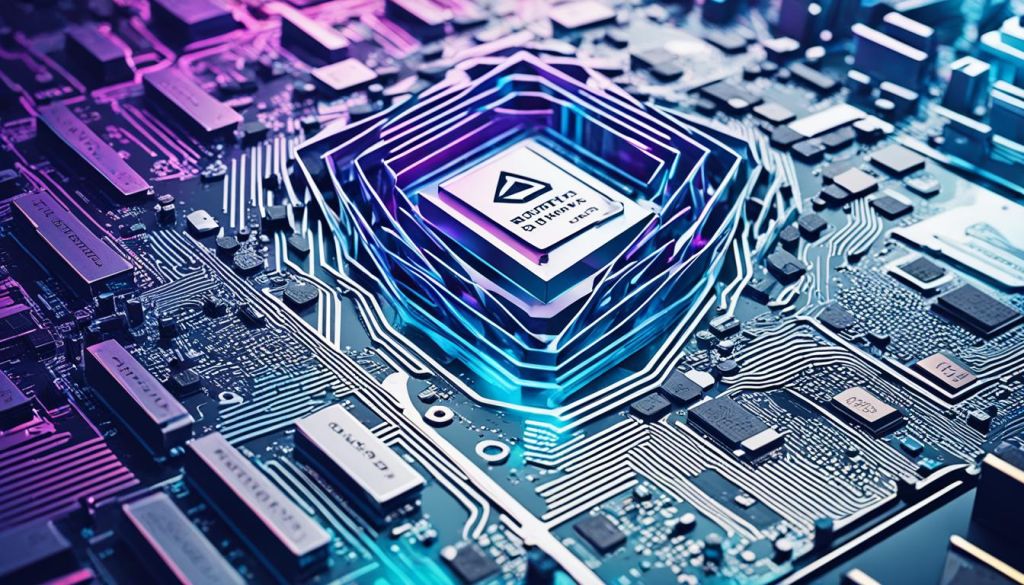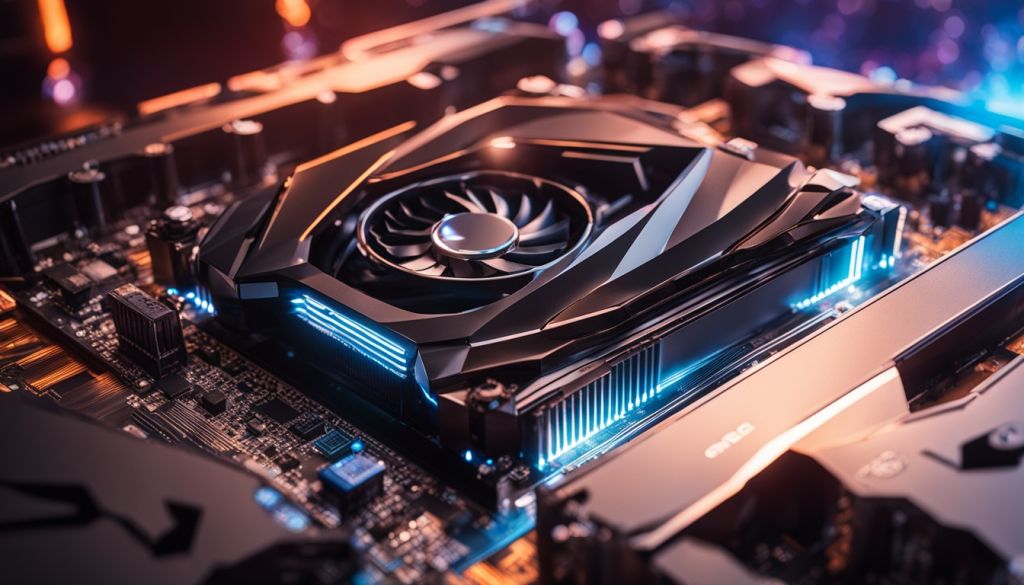Did you know the latest Nvidia RTX 4090 graphics card beats its last version by 55%? In the 2024 benchmarks, it shows off its unmatched power. This GPU stands at the top, setting new bars for the GPU market.
The benchmarks show how better the new cards are over old and current ones. They look at how well cards work for gaming, rendering benchmarks, AI accelerators, and datacenter GPUs. Understanding this info helps you pick the right card for your gaming or work.
At the head of the list is the Nvidia RTX 4090. It offers amazing ray tracing performance and graphic quality. But, it costs around $1,849, which might be too much. For those looking for a good deal, the RTX 4080 Super takes second place. It shows that not all great cards are the most expensive.
Looking into these benchmarks shows you what each card does best. It gives you the power to choose wisely, whether for gaming, High-end rendering, or AI work. Stick around to see which cards shine the brightest in our 2024 reviews.
Introduction to GPU Benchmarks Hierarchy
The GPU benchmarks hierarchy ranks graphics cards based on their performance. It shows the differences in performance between various models. This helps you make smart choices when buying a graphics card.
This system looks at many areas, from playing games to professional uses like AI. It stays relevant by regularly testing new GPUs. This makes it a trusted source for understanding what today’s graphics cards can do.
Factors Influencing GPU Performance
The GPU architecture is key in how well a graphics card performs. For instance, Nvidia’s Ampere or AMD’s RDNA make a difference. Features like ray tracing cores and tensor cores can boost a GPU’s power. New architectures bring better tech that’s more efficient than before.
Core Count and Clock Speeds
The number of cores and their clock speeds matter for a GPU’s power. More cores and faster speeds mean better performance in games and AI acceleration. But, how efficient and optimized these are in their design is important too.
Video Memory
The video memory a GPU has significantly impacts its performance. Having more and faster memory like GDDR6X or HBM2 helps in handling bigger textures and high-res pictures. The memory’s bandwidth and interface width are also vital for how well a GPU works.
The GPU benchmarks hierarchy 2024
The GPU benchmarks hierarchy shows us the best graphics cards. It tells us how well they perform across different tasks. In the 2024 edition, we’ll see which cards stand out the most.
Nvidia RTX 4090
The Nvidia RTX 4090 is at the top. It has 16,384 CUDA cores and a 2,520 MHz boost clock. Plus, it holds a massive 24GB of GDDR6X memory. This makes it great for both standard and advanced graphics tasks. As a result, it’s the leading card for the year.
AMD Radeon RX 7900 XTX
AMD’s Radeon RX 7900 XTX challenges Nvidia’s top spot. It runs on the RDNA 3 architecture. This makes it very powerful for graphics work, whether in gaming or rendering.
Nvidia RTX 4080 Super
The Nvidia RTX 4080 Super comes in third. It offers amazing performance but at a lower cost. While not as powerful as the RTX 4090, it’s a strong choice for many users.
Nvidia RTX 4090
The Nvidia RTX 4090 leads with perfect scores at 1080p in “ultra” settings. Its power and features make it stand out. It’s the prime pick for gamers, and professionals.
AMD Radeon RX 7900 XTX
The AMD Radeon RX 7900 XTX competes well with efficient yet powerful performance. It’s great for gaming or work tasks. This shows AMD’s progress in GPU technology.
Nvidia RTX 4080 Super
The Nvidia RTX 4080 Super balances performance and price. It doesn’t match the RTX 4090 in power but offers great value. It’s a top choice for those wanting high performance without the highest cost.
Ranking Methodology
The GPU benchmarks hierarchy uses 8 top games in its tests. This includes Borderlands 3, Far Cry 6, and others. These games check different graphics processing units (GPUs) in different situations.
Test Suite and Benchmarking Tools
Testing uses standard benchmarking tools. This makes sure the results are fair for all hardware setups. It lets us compare graphics processing units (GPUs) accurately.
Performance Metrics
The GPU benchmarks hierarchy looks at gaming, AI accelerators, and datacenter GPUs. This method ranks GPUs based on what gamers, creators, and pros need. It gives a full picture of the GPU’s performance.

Top GPUs for Gaming
The Nvidia RTX 4090 and AMD Radeon RX 7900 XTX lead the charts in GPU benchmarks. They shine in gaming with top performance, especially at 4K. These graphics cards deliver high frame rates at the most demanding settings, making games look stunning.
For those looking for a balance of power and cost, the RTX 4080 Super and RTX 4070 Ti Super are good choices. They offer good performance without breaking the bank. Don’t forget the importance of power efficiency, managing heat, and cool features like ray tracing and AI enhancements. These add a lot to how fun your gaming experience is.
AMD does well too, with their RDNA 3 architecture shining in the RX 7900 XT and RX 7900 GRE. These cards are great for 1440p and 1080p gaming, showing that you don’t always need the highest end for a great experience.
| GPU Model | Rasterization Performance | Ray Tracing Performance | Power Efficiency |
|---|---|---|---|
| Nvidia RTX 4090 | Exceptional | Excellent | Good |
| AMD Radeon RX 7900 XTX | Excellent | Good | Very Good |
| Nvidia RTX 4080 Super | Very Good | Very Good | Good |
| Nvidia RTX 4070 Ti Super | Excellent | Good | Very Good |
| AMD Radeon RX 7900 XT | Excellent | Good | Excellent |
| AMD Radeon RX 7900 GRE | Very Good | Good | Excellent |
Top GPUs for Professional Applications
The Nvidia RTX 4090 and AMD Radeon RX 7900 XTX are at the top in handling 3D rendering tasks. They can manage challenging models, detailed textures, and complex lighting. This makes them stand out.
3D Rendering
The number of CUDA cores and memory bandwidth greatly affect a GPU’s rendering speed. The latest hardware architectures are better than before, offering more power. Things like hardware-accelerated ray tracing and AI-powered denoising boost both work quality and speed.
AI and Machine Learning
Graphics cards are also tested for AI and machine learning roles. Factors like having tensor cores, using AI for speed, and total computational power decide which GPU does best. These aspects are key for outstanding performance on these critical jobs.
Power Efficiency and Thermal Performance
The GPU benchmarks not only look at performance but also power efficiency and heat. The newest Nvidia 40-series and AMD RDNA 3 GPUs are better at being energy efficient. The RTX 4070 Super and RX 7900 GRE are great at this.
Power use and heat are very important. They affect how a system is built and how it’s cooled. This matters a lot for jobs where energy use should be kept low, like in big companies. The rankings show the balance between how well a card works and how much energy it uses. From this, you can pick the best one for your needs.
Many things, like the way a GPU is designed and how it’s made, affect its power use and heat. The rankings help you see what each GPU needs in terms of energy and cooling. This makes choosing the right one easier for your work or play.
| GPU Model | Power Efficiency (GFLOPS/W) | Thermal Design Power (TDP) |
|---|---|---|
| Nvidia RTX 4090 | 29.1 | 450W |
| AMD Radeon RX 7900 XTX | 31.4 | 355W |
| Nvidia RTX 4080 Super | 33.2 | 420W |
| AMD Radeon RX 7900 XT | 28.9 | 315W |
| Nvidia RTX 4070 Super | 35.7 | 300W |
Ray Tracing Performance
The GPU benchmarks hierarchy looks at how well graphics cards handle ray tracing performance. Ray tracing is getting really important for gaming and professional applications.
Nvidia DLSS and AMD FSR
Nvidia’s DLSS (Deep Learning Super Sampling) and AMD’s FSR (FidelityFX Super Resolution) are big helps. They use smart AI-powered upscaling techniques to keep games looking great. This happens while still keeping the game running smooth and fast with ray-traced effects. These technologies are a must for ray tracing workloads.
These tools show us how much graphics cards can do with ray tracing. They show the difference between GPUs with and without ray tracing. It also shows how DLSS and FSR make a big difference. The ability to use these rendering technologies shows if a GPU is good for tough jobs. These jobs include real-time 3D rendering, architectural visualization, and cinematic visual effects.

Value Proposition
The GPU benchmarks hierarchy looks at more than just raw power. It also checks the price compared to the performance you get. This is important for many people. It helps them find GPUs that give good performance for their price, like the Nvidia RTX 4070 Super and the AMD Radeon RX 7900 GRE.
Price-to-Performance Ratio
These mid-range and high-end choices perform well and have many features. Yet, they don’t cost as much as the very top models. By looking at the price and what you get, you can find the best value GPU. This is useful if you’re building a new system, upgrading one, or need a GPU for work.
Thinking about both the performance and the price helps you choose wisely. The hierarchy lets you pick a GPU that fits your budget and needs. It’s a great way to check out the latest graphics cards and choose the one that offers the best value for you.
Manufacturer Comparisons
GPU benchmarks hierarchy shows how Nvidia and AMD stack up. It lets people see the good and bad of each brand’s GPUs. This helps users decide which one fits their needs best.
Nvidia vs. AMD
Nvidia’s RTX 40-series is top, with models like RTX 4090 and RTX 4080 Super. They bring cool tech like ray tracing and AI. Nvidia shines in hardware performance and energy efficiency. It’s at the front of the graphics processing units field.
AMD has the Radeon RX 7900 XTX series, built on RDNA 3 architecture. These offer great rasterization performance and are efficient. AMD focuses on great gaming benchmarks and rendering benchmarks. Their GPUs are ideal for gamers and pros alike.
The GPU benchmarks hierarchy lets people see each brand’s strengths. This helps users pick the right one for their needs.
Intel Arc GPUs
Intel Arc GPUs are the newest entry in the field. They join Nvidia and AMD in the race. The GPU benchmarks hierarchy now shows where they stand compared to the older competitors.
Intel Arc GPUs hold their own, especially in the middle and entry levels. They’re strong in gaming benchmarks and rendering benchmarks. But they’re not top-tier just yet. Intel is working to improve. The GPU benchmarks hierarchy will keep track of their progress.
Future GPU Trends and Expectations
The world of GPU benchmarks is always changing. This change gives us a sneak peek into future graphics processing units. We’re looking forward to Nvidia’s Blackwell and RTX 50-series, AMD’s RDNA 4, and Intel’s Battlemage GPUs. With these new releases on the horizon, we expect big changes in the GPU performance world.
Next-Generation Architectures
New GPU architectures mean big upgrades in performance, energy efficiency, and features. This will change what we can do with graphic hardware. The power and performance of these new designs will be examined closely. This will help people understand how hardware performance and gaming benchmarks are changing.
Advancements in Ray Tracing
The next-gen GPUs are also set to boost ray tracing a lot. They’ll get better with help from AI accelerators and datacenter GPUs. We’ll watch how technologies like Nvidia’s DLSS and AMD’s FSR improve GPU performance.
Keeping an eye on the the gpu benchmarks hierarchy 2024 will help users. It will guide them in choosing the right GPUs for their needs. This is vital when upgrading or building their next computers. They’ll aim for GPUs that are both energy and hardware efficient.

Choosing the Right GPU for Your Needs
Looking for a graphics card? The GPU benchmarks hierarchy is a great help. It ranks GPU models by performance, making it easier to choose one that fits your needs. This way, you can be sure you’re making the best choice.
Are you a gamer who wants the best graphics and speed? Or maybe you create content that needs top-notch rendering? Even if you’re into AI and need a GPU for machine learning, this system is for you. It looks at things like how fast it can show images, if it can do cool lighting effects, how much power it uses, and if it’s a good deal for the money. This info guides you to the perfect GPU for what you do.
When you’re picking between GPUs from big names like Nvidia and AMD, knowing the details helps. You’ll feel more certain about choosing in the fast-changing world of graphics cards. Plus, staying updated on new tech, like DLSS and FSR, can help you make a wise, long-term choice. It’ll keep you happy even as the tech world moves forward.





Leave a Comment